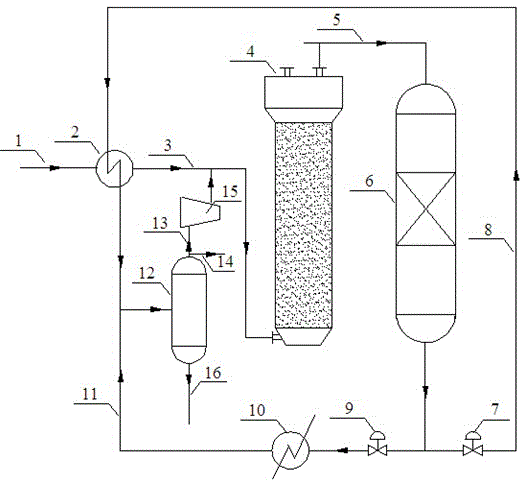A process for producing gasoline from synthetic gas
A synthesis gas and gasoline technology, applied in the petroleum industry, the preparation of liquid hydrocarbon mixtures, etc., can solve the problems of catalyst sintering deactivation, catalyst deactivation, catalyst life shortening, etc., to improve energy utilization, reduce energy consumption and Effect of cost and equipment investment increase
- Summary
- Abstract
- Description
- Claims
- Application Information
AI Technical Summary
Problems solved by technology
Method used
Image
Examples
Embodiment 1
[0032] Step (1) Synthesis gas 1 is mainly produced by coal gasification or natural gas cracking, with a hydrogen-to-carbon volume ratio of 2, pressurized to 2.5MPa, and heat-exchanges with the tail gas 8 of the preheated synthesis gas through the heat exchanger 2, and the preheated After heating, it enters the slurry bed reactor 4.
[0033] Step (2) Slurry bed reactor 2 adopts air flow bubbling suspension slurry bed reactor, uses liquid paraffin as inert liquid phase heat carrier, reaction temperature is 240°C, reaction pressure is 2.5MPa, and space velocity is 6000ml·g -1 h -1, the syngas is dehydrated into dimethyl ether by a bifunctional catalyst (a bifunctional catalyst LP201+TH16 developed by Tsinghua University (LP201 mass content 67%, TH16 mass content 33%)) in the reactor, in which the single-pass conversion rate of CO is 65% .
[0034] Step (3) The tail gas 5 after the slurry bed reaction directly enters the fixed bed reactor 6, and the fixed bed reactor 6 is equipp...
Embodiment 2
[0039] Step (1) Synthesis gas 1 is mainly produced by coal gasification or natural gas cracking, with a hydrogen-to-carbon volume ratio of 3, pressurized to 2.0 MPa, and exchanges heat with the tail gas 8 of the preheated synthesis gas through the heat exchanger 2. After heating, it enters the slurry bed reactor 4.
[0040] Steps (3), (4), (5) are the same as in Example 1
[0041] Step (2) Slurry bed reactor 4 adopts air flow bubbling to suspend slurry bed reactor, uses liquid paraffin as inert liquid phase heat carrier, and uses n-hexane as supercritical medium, reaction temperature 250°C, reaction pressure 3MPa, space velocity 5000ml·g -1 h -1 , the syngas is dehydrated into dimethyl ether by a bifunctional catalyst (a bifunctional catalyst LP201+TH16 developed by Tsinghua University (LP201 mass content 67%, TH16 mass content 33%)) in the reactor, in which the single-pass conversion rate of CO is 65% , H 2 The single-pass conversion rate is 62%.
[0042] The obtained ga...
Embodiment 3
[0044] Step (1) Synthesis gas 1 is mainly produced by coal gasification or natural gas cracking, with a hydrogen-to-carbon volume ratio of 2.5, pressurized to 4.0 MPa, and exchanges heat with the tail gas 8 of the preheated synthesis gas through the heat exchanger 2. After heating, it enters the slurry bed reactor 4.
[0045] Steps (3), (4), (5) are the same as in Example 1
[0046] Step (2) The slurry bed reactor 4 adopts a mechanically stirred tank type slurry bed, uses liquid paraffin as an inert liquid phase heat carrier, and uses n-hexane as a supercritical medium, the reaction temperature is 230°C, the reaction pressure is 4MPa, and the space velocity is 3000ml· g -1 h -1 , the synthesis gas passes through the bifunctional catalyst in the reactor (the bifunctional catalyst CN1176742C developed by Nanhua Group, the composition of the catalyst mainly includes metal oxides and acidic components, and the suitable weight content of metal oxides: CuO is 30% , ZnO is 20%, an...
PUM
 Login to View More
Login to View More Abstract
Description
Claims
Application Information
 Login to View More
Login to View More - R&D
- Intellectual Property
- Life Sciences
- Materials
- Tech Scout
- Unparalleled Data Quality
- Higher Quality Content
- 60% Fewer Hallucinations
Browse by: Latest US Patents, China's latest patents, Technical Efficacy Thesaurus, Application Domain, Technology Topic, Popular Technical Reports.
© 2025 PatSnap. All rights reserved.Legal|Privacy policy|Modern Slavery Act Transparency Statement|Sitemap|About US| Contact US: help@patsnap.com

